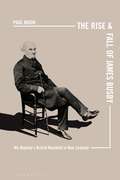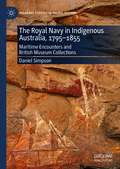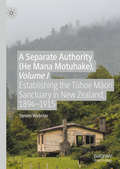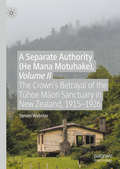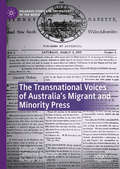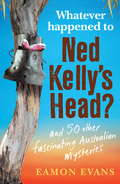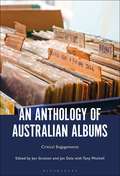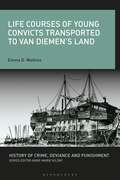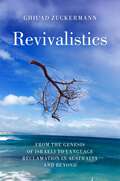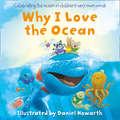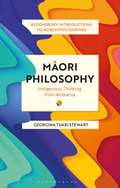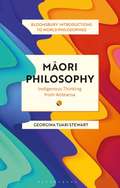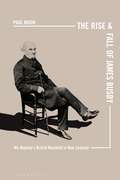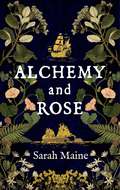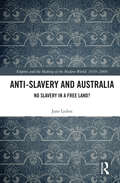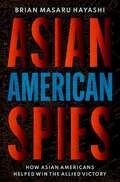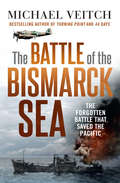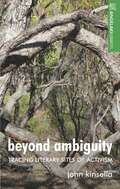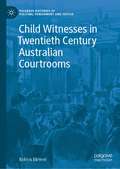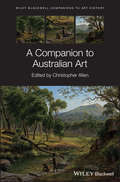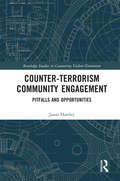- Table View
- List View
The Rise and Fall of James Busby: His Majesty’s British Resident in New Zealand
by Paul MoonOne of the British Empire's most troubling colonial exports in the 19th-century, James Busby is known as the father of the Australian wine industry, the author of New Zealand's Declaration of Independence and a central figure in the early history of independent New Zealand as its British Resident from 1833 to 1840.Officially the man on the ground for the British government in the volatile society of New Zealand in the 1830s, Busby endeavoured to create his own parliament and act independently of his superiors in London. This put him on a collision course with the British Government, and ultimately destroyed his career. With a reputation as an inept, conceited and increasingly embittered person, this caricature of Busby's character has slipped into the historical bloodstream where it remains to the present day. This book draws on an extensive range of previously-unused archival records to reconstruct Busby's life in much more intimate form, and exposes the back-room plotting that ultimately destroyed his plans for New Zealand. It will alter the way that Britain's colonisation of New Zealand is understood, and will leave readers with an appreciation of how individuals, more than policies, shaped the Empire and its rule.
The Royal Navy in Indigenous Australia, 1795–1855: Maritime Encounters and British Museum Collections (Palgrave Studies in Pacific History)
by Daniel SimpsonThis book offers the first in-depth enquiry into the origins of 135 Indigenous Australian objects acquired by the Royal Navy between 1795 and 1855 and held now by the British Museum. In response to increasing calls for the ‘decolonisation’ of museums and the restitution of ethnographic collections, the book seeks to return knowledge of the moments, methods, and motivations whereby Indigenous Australian objects were first collected and sent to Britain. By structuring its discussion in terms of three key ‘stages’ of a typical naval voyage to Australia—departure from British shores, arrival on the continent’s coasts, and eventual return to port—the book offers a nuanced and multifaceted understanding of the pathways followed by these 135 objects into the British Museum. The book offers important new understandings of Indigenous Australian peoples’ reactions to naval visitors, and contains a wealth of original research on the provenance and meaning of some of the world’s oldest extant Indigenous Australian object collections.
A Separate Authority (He Mana Motuhake), Volume I: Establishing the Tūhoe Māori Sanctuary in New Zealand, 1894–1915
by Steven WebsterThis book is an ethnohistorical reconstruction of the establishment in New Zealand of a rare case of Maori home-rule over their traditional domain, backed by a special statute and investigated by a Crown commission the majority of whom were Tūhoe leaders. However, by 1913 Tūhoe home-rule over this vast domain was being subverted by the Crown, which by 1926 had obtained three-quarters of their reserve. By the 1950s this vast area had become the rugged Urewera National Park, isolating over 200 small blocks retained by stubborn Tūhoe "non-sellers". After a century of resistance, in 2014 the Tūhoe finally regained statutory control over their ancestral domain and a detailed apology from the Crown.
A Separate Authority (He Mana Motuhake), Volume II: The Crown’s Betrayal of the Tūhoe Māori Sanctuary in New Zealand, 1915–1926
by Steven WebsterFollowing on from Volume I on the formation of the Urewera District Native Reserve, this monograph examines the period from 1908 to 1926, during which time the Crown subverted Tūhoe control of the UDNR, established a mere decade earlier. While Volume I described how the Tūhoe were able to deploy kin-based power to manipulate Crown power as well as confront one another, this volume describes ways in which the same ancestral descent groups closed ranks to survive nearly two decades of predatory Crown policies determined to dismantle their sanctuary. A relentless Crown campaign to purchase individual Tūhoe land shares ultimately resulted in a misleading Crown scheme to consolidate and relocate Tūhoe land shares, thereby freeing up land for the settlement of non- Tūhoe farmers. By the 1950s, over 200 small Tūhoe blocks were scattered throughout one of the largest National Parks in New Zealand. Although greatly weakened by these policies in terms of kinship solidarity as well as land and other resources, Tūhoe resistance continued until the return of the entire park in 2014—with unreserved apologies and promises of future support. In both volumes of A Separate Authority (He Mana Motuhake), Webster takes the stance of an ethnohistorian: he not only examines the various ways control over the Urewera District Native Reserve (UDNR) was negotiated, subverted or betrayed, and renegotiated during this time period, but also focuses on the role of Māori hapū, ancestral descent groups and their leaders, including the political economic influence of extensive marriage alliances between them. The ethnohistorical approach developed here may be useful to other studies of governance, indigenous resistance, and reform, whether in New Zealand or elsewhere.
The Transnational Voices of Australia’s Migrant and Minority Press (Palgrave Studies in the History of the Media)
by Catherine Dewhirst Richard ScullyThis edited collection invites the reader to enter the diverse worlds of Australia’s migrant and minority communities through the latest research on the contemporary printed press, spanning the mid-nineteenth century to our current day. With a focus on the rare, radical and foreign-language print culture of multiple and frequently concurrent minority groups’ newspaper ventures, this volume has two overarching aims: firstly to demonstrate how the local experiences and narratives of such communities are always forged and negotiated within a context of globalising forces – the global within the local; and secondly to enrich an understanding of the complexity of Australian ‘voices’ through this medium not only as a means for appreciating how the cultural heritage of such communities were sustained, but also for exploring their contributions to the wider society.
Whatever Happened to Ned Kelly’s Head?
by Eamon EvansAll rights reserved. No part of this publication may be reproduced without prior permission of the publisher.
An Anthology of Australian Albums: Critical Engagements
An Anthology of Australian Albums offers an overview of Australian popular music through the lens of significant, yet sometimes overlooked, Australian albums. Chapters explore the unique qualities of each album within a broader history of Australian popular music. Artists covered range from the older and non-mainstream yet influential, such as the Missing Links, Wendy Saddington and the Coloured Balls, to those who have achieved very recent success (Courtney Barnett, Dami Im and Flume) and whose work contributes to international pop music (Sia), to the more exploratory or experimental (Curse ov Dialect and A.B. Original). Collectively the albums and artists covered contribute to a view of Australian popular music through the non-canonical, emphasizing albums by women, non-white artists and Indigenous artists, and expanding the focus to include genres outside of rock including hip hop, black metal and country.
Life Courses of Young Convicts Transported to Van Diemen's Land (History of Crime, Deviance and Punishment)
by Emma D. WatkinsDrawing on digital criminal records, this book traces the life courses of young convicts who were sentenced at the Old Bailey and transported to Van Diemen's Land in the early 19th century. It explores the everyday lives of the convicts pre- and post-transportation, focusing on their crimes, punishments, education, employment and family life right up to their deaths. Emma D. Watkins contextualizes these young convicts within the punishment system, economy and culture that they were thrust into by their forced movement to Australia. This allows an understanding of the factors which determined their chances of achieving a 'settled life' away from crime in the colony.Packed with case studies offering vivid accounts of the offenders' lives, Life Courses of Young Convicts Transported to Van Diemen's Land makes an important contribution to the history of transportation, social history and Australian history.
Revivalistics: From the Genesis of Israeli to Language Reclamation in Australia and Beyond
by Ghil'ad ZuckermannIn this book, Ghil'ad Zuckermann introduces revivalistics, a new trans-disciplinary field of enquiry surrounding language reclamation, revitalization, and reinvigoration. Applying lessons from the Hebrew revival of the late nineteenth and early twentieth centuries to contemporary endangered languages, Zuckermann takes readers along a fascinating and multifaceted journey into language revival and provides new insights into language genesis. Beginning with a critical analysis of Israeli-the language resulting from the Hebrew revival-Zuckermann's radical theory contradicts conventional accounts of the Hebrew revival and challenges the family tree model of historical linguistics. Revivalistics demonstrates how grammatical cross-fertilization with the revivalists' mother tongues is inevitable in the case of successful "revival languages." The second part of the book then applies these lessons from the Israeli language to revival movements in Australia and globally, describing the "why" and "how" of revivalistics. With examples from the Barngarla Aboriginal language of South Australia, Zuckermann proposes ethical, aesthetic, and utilitarian reasons for language revival and offers practical methods for reviving languages. Based on years of the author's research, fieldwork, and personal experience with language revivals all over the globe, Revivalistics offers ground-breaking theoretical and pragmatic contributions to the field of language reclamation, revitalization, and reinvigoration.
Why I Love the Ocean
by Daniel HowarthFeaturing children’s own words along with heart-warming pictures, this book is a perfect celebration of all that’s special about the ocean!
Maori Philosophy: Indigenous Thinking from Aotearoa (Bloomsbury Introductions to World Philosophies)
by Georgina StewartCovering the symbolic systems and worldviews of the Indigenous peoples of Aotearoa, New Zealand, this book is a concise introduction to Maori philosophy. It addresses core philosophical issues including Maori notions of the self, the world, epistemology, the form in which Maori philosophy is conveyed, and whether or not Maori philosophy has a teleological agenda. Introducing students to key texts, thinkers and themes, the book includes: - A Maori-to-English glossary and an index - Accessible interpretations of primary source material - Teaching notes, and reflections on how the studied material engages with contemporary debates - End-of-chapter discussion questions that can be used in teaching - Comprehensive bibliographies and guided suggestions for further reading. Maori Philosophy is an ideal text for students studying World Philosophies, or anyone who wishes to use Indigenous philosophies or methodologies in their own research and scholarship.
Maori Philosophy: Indigenous Thinking from Aotearoa (Bloomsbury Introductions to World Philosophies)
by Georgina StewartCovering the symbolic systems and worldviews of the Indigenous peoples of Aotearoa, New Zealand, this book is a concise introduction to Maori philosophy. It addresses core philosophical issues including Maori notions of the self, the world, epistemology, the form in which Maori philosophy is conveyed, and whether or not Maori philosophy has a teleological agenda. Introducing students to key texts, thinkers and themes, the book includes: - A Maori-to-English glossary and an index - Accessible interpretations of primary source material - Teaching notes, and reflections on how the studied material engages with contemporary debates - End-of-chapter discussion questions that can be used in teaching - Comprehensive bibliographies and guided suggestions for further reading. Maori Philosophy is an ideal text for students studying World Philosophies, or anyone who wishes to use Indigenous philosophies or methodologies in their own research and scholarship.
The Rise and Fall of James Busby: His Majesty’s British Resident in New Zealand
by Paul MoonOne of the British Empire's most troubling colonial exports in the 19th-century, James Busby is known as the father of the Australian wine industry, the author of New Zealand's Declaration of Independence and a central figure in the early history of independent New Zealand as its British Resident from 1833 to 1840.Officially the man on the ground for the British government in the volatile society of New Zealand in the 1830s, Busby endeavoured to create his own parliament and act independently of his superiors in London. This put him on a collision course with the British Government, and ultimately destroyed his career. With a reputation as an inept, conceited and increasingly embittered person, this caricature of Busby's character has slipped into the historical bloodstream where it remains to the present day. This book draws on an extensive range of previously-unused archival records to reconstruct Busby's life in much more intimate form, and exposes the back-room plotting that ultimately destroyed his plans for New Zealand. It will alter the way that Britain's colonisation of New Zealand is understood, and will leave readers with an appreciation of how individuals, more than policies, shaped the Empire and its rule.
Alchemy and Rose: A sweeping new novel from the author of The House Between Tides, the Waterstones Scottish Book of the Year
by Sarah MaineA beautiful and sweeping historical novel that takes the reader from the west coast of New Zealand, to Scotland and Melbourne in the 1870s1866. Will Stewart is one of many who have left their old lives behind to seek their fortunes in New Zealand's last great gold rush. The conditions are hostile and the outlook bleak, but he must push on in his uncertain search for the elusive buried treasure.Rose is about to arrive on the shores of South Island when a storm hits and her ship is wrecked. Just when all seems lost she is snatched from the jaws of death by Will, who risks his life to save her. Drawn together by circumstance, they stay together by choice and for a while it seems that their stars have finally aligned.But after a terrible misunderstanding they are cruelly separated, and their new-found happiness is shattered. As Will chases Rose across oceans and continents, he must come to terms with the possibility that he might never see her again. And if he does, he will have to face the man who took her . . .
Anti-Slavery and Australia: No Slavery in a Free Land? (Empire and the Making of the Modern World, 1650-2000)
by Jane LydonBringing the histories of British anti-slavery and Australian colonization together changes our view of both. This book explores the anti-slavery movement in imperial scope, arguing that colonization in Australasia facilitated emancipation in the Caribbean, even as abolition powerfully shaped the Settler Revolution. The anti-slavery campaign was deeply entwined with the administration of the empire and its diverse peoples, as well as the radical changes demanded by industrialization and rapid social change in Britain. Abolition posed problems to which colonial expansion provided the answer, intimately linking the end of slavery to systematic colonization and Indigenous dispossession. By defining slavery in the Caribbean as the opposite of freedom, a lasting impact of abolition was to relegate other forms of oppression to lesser status, or to deny them. Through the shared concerns of abolitionists, slave-owners, and colonizers, a plastic ideology of ‘free labour’ was embedded within post-emancipation imperialist geopolitics, justifying the proliferation of new forms of unfree labour and defining new racial categories. The celebration of abolition has overshadowed post-emancipation continuities and transformations of slavery that continue to shape the modern world.
Anti-Slavery and Australia: No Slavery in a Free Land? (Empire and the Making of the Modern World, 1650-2000)
by Jane LydonBringing the histories of British anti-slavery and Australian colonization together changes our view of both. This book explores the anti-slavery movement in imperial scope, arguing that colonization in Australasia facilitated emancipation in the Caribbean, even as abolition powerfully shaped the Settler Revolution. The anti-slavery campaign was deeply entwined with the administration of the empire and its diverse peoples, as well as the radical changes demanded by industrialization and rapid social change in Britain. Abolition posed problems to which colonial expansion provided the answer, intimately linking the end of slavery to systematic colonization and Indigenous dispossession. By defining slavery in the Caribbean as the opposite of freedom, a lasting impact of abolition was to relegate other forms of oppression to lesser status, or to deny them. Through the shared concerns of abolitionists, slave-owners, and colonizers, a plastic ideology of ‘free labour’ was embedded within post-emancipation imperialist geopolitics, justifying the proliferation of new forms of unfree labour and defining new racial categories. The celebration of abolition has overshadowed post-emancipation continuities and transformations of slavery that continue to shape the modern world.
Asian American Spies: How Asian Americans Helped Win the Allied Victory
by Brian Masaru HayashiA recovery of the vital role Chinese, Japanese, and Korean Americans played in US intelligence services in Asia during World War II. Spies deep behind enemy lines; double agents; a Chinese American James Bond; black propaganda radio broadcasters; guerrilla fighters; pirates; smugglers; prostitutes and dancers as spies; and Asian Americans collaborating with Axis Powers. All these colorful individuals form the story of Asian Americans in the Office of Strategic Services (OSS), the forerunner of today's CIA. Brian Masaru Hayashi brings to light for the first time the role played by Chinese, Japanese, and Korean Americans in America's first centralized intelligence agency in its fight against the Imperial Japanese forces in east Asia during World War II. They served deep behind enemy lines gathering intelligence for American and Chinese troops locked in a desperate struggle against Imperial Japanese forces on the Asian continent. Other Asian Americans produced and disseminated statements by bogus peace groups inside the Japanese empire to weaken the fighting resolve of the Japanese. Still others served with guerrilla forces attacking enemy supply and communication lines behind enemy lines. Engaged in this deadly conflict, these Asian Americans agents encountered pirates, smugglers, prostitutes, and dancers serving as the enemy's spies, all the while being subverted from within the OSS by a double agent and without by co-ethnic collaborators in wartime Shanghai. Drawing on recently declassified documents, Asian American Spies challenges the romanticized and stereotyped image of these Chinese, Japanese, and Korean American agents--the Model Minority-while offering a fresh perspective on the Allied victory in the Pacific Theater of World War II.
The Battle of the Bismarck Sea
by Michael VeitchIn the thick of World War II, during the first week of March 1943, Japan made a final, desperate lunge for control of the South West Pacific. In the ensuing Battle of the Bismarck Sea, a force of land-based Australian and American planes attacked a massive convoy of Japanese warships. The odds were against them. But a devastating victory was won and Japan's hopes of regaining the initiative in New Guinea destroyed. More importantly for Australians, the victory decisively removed any possibility that Australia might be invaded by Japanese forces. It was, for us, one of the most significant times in our history - a week when our future was profoundly in the balance. Bestselling author Michael Veitch tells the riveting story of this crucial moment in history - how the bravery of young men and experienced fighters, renegades and rule-followers, overcame some of the darkest days of World War II.
Beyond ambiguity: Tracing literary sites of activism (Angelaki Humanities)
by John KinsellaThis volume completes John Kinsella’s trilogy of critical activist poetics, begun two decades ago. It challenges familiar topoi and normatives of poetic activity as it pertains to environmental, humanitarian and textual activism in ‘the world-at-large’: it shows how ambiguity can be a generative force when it works from a basis of non-ambiguity of purpose. The book shows how there is a clear unambiguous position to have regarding issues of justice, but that from that confirmed point ambiguity can be an intense and useful activist tool. The book is an essential resource for those wishing to study Kinsella, and for those with an interest in twentieth and twenty-first-century poetry and poetics, and it will stand as an inspiring proclamation of the author's faith in the transformative power of poetry and literary activity as a force for good in the world.
Beyond ambiguity: Tracing literary sites of activism (Angelaki Humanities)
by John KinsellaThis volume completes John Kinsella’s trilogy of critical activist poetics, begun two decades ago. It challenges familiar topoi and normatives of poetic activity as it pertains to environmental, humanitarian and textual activism in ‘the world-at-large’: it shows how ambiguity can be a generative force when it works from a basis of non-ambiguity of purpose. The book shows how there is a clear unambiguous position to have regarding issues of justice, but that from that confirmed point ambiguity can be an intense and useful activist tool. The book is an essential resource for those wishing to study Kinsella, and for those with an interest in twentieth and twenty-first-century poetry and poetics, and it will stand as an inspiring proclamation of the author's faith in the transformative power of poetry and literary activity as a force for good in the world.
Child Witnesses in Twentieth Century Australian Courtrooms (Palgrave Histories of Policing, Punishment and Justice)
by Robyn BlewerThis book considers the law, policy and procedure for child witnesses in Australian criminal courts across the twentieth century. It uses the stories and experiences of over 200 children, in many cases using their own words from press reports, to highlight how the relevant law was – or was not - applied throughout this period. The law was sympathetic to the plight of child witnesses and exhibited a significant degree of pragmatism to receive the evidence of children but was equally fearful of innocent men being wrongly convicted. The book highlights the impact ‘safeguards’ like corroboration and closed court rules had on the outcome of many cases and the extent to which fear – of children, of lies (or the truth) and of reform – influenced the criminal justice process. Over a century of children giving evidence in court it is `clear that the more things changed, the more they stayed the same’.
A Companion to Australian Art (Blackwell Companions to Art History)
by Dana ArnoldAn accessible and balanced introduction to the history of Australian art from colonization to the present The Companion to Australian Art is a thorough introduction to the art produced in Australia beginning from the arrival of the First Fleet in 1788. Focusing on the colonial art tradition of Australia's European settlers, this volume presents a collection of clear, accessible, and well-focused essays by established art historians and emerging scholars alike. Engaging, jargon-free chapters provide fresh insights on various Australian artforms in different chronological, regional, and thematic contexts. The text provides a balanced and unbiased description of historical events to help readers encounter the art of Australia on their own terms and draw their own conclusions. The book begins by surveying the historiography of Australian art and exploring the history of art museums in Australia. The following chapters discuss artforms such as photography, sculpture, portraiture, and landscape painting, and examine the art traditions of the separate colonies up to Federation in 1901, and then the art tradition of the Commonwealth from the early nineteenth century to the present. This authoritative volume: Helps non-specialist readers understand and appreciate the art of Australia Covers 250 years of art movements in Australia, including Neo-classicism, Romanticism, Realism, Impressionism, and the various forms of Modernism Explores the way Australian art has been considered and exhibited since the beginning of colonization Discusses the state of contemporary art and how traditional Aboriginal art has adapted and changed over the last half-century Offers new perspectives on cultural and aesthetic debates both past and present The Companion to Australian Art is a valuable resource for both undergraduate and graduate students of the history of Australian artforms from colonization to postmodernism, and for general readers with an interest in the nation’s colonial art history.
A Companion to Australian Art (Blackwell Companions to Art History)
by Dana ArnoldA Companion to Australian Art A Companion to Australian Art is a thorough introduction to the art produced in Australia from the arrival of the First Fleet in 1788 to the early 21st century. Beginning with the colonial art made by Australia’s first European settlers, this volume presents a collection of clear and accessible essays by established art historians and emerging scholars alike. Engaging, clearly-written chapters provide fresh insights into the principal Australian art movements, considered from a variety of chronological, regional and thematic perspectives.The text seeks to provide a balanced account of historical events to help readers discover the art of Australia on their own terms and draw their own conclusions. The book begins by surveying the historiography of Australian art and exploring the history of art museums in Australia. The following chapters discuss art forms such as photography, sculpture, portraiture and landscape painting, examining the practice of art in the separate colonies before Federation, and in the Commonwealth from the early 20th century to the present day. This authoritative volume covers the last 250 years of art in Australia, including the Early Colonial, High Colonial and Federation periods as well as the successive Modernist styles of the 20th century, and considers how traditional Aboriginal art has adapted and changed over the last fifty years.The Companion to Australian Art is a valuable resource for both undergraduate and graduate students of the history of Australian artforms from colonization to postmodernism, and for general readers with an interest in the nation’s colonial art history.
Counter-Terrorism Community Engagement: Pitfalls and Opportunities (Routledge Studies in Countering Violent Extremism)
by Jason HartleyThis book offers insights into the building of trust in Muslim communities through community engagement in a climate of counter-terrorism. Police engagement with Muslim communities is complex with a history of distrust. This book first attempts to understand the role and implications of uncertainty on community engagement in Muslim communities, and then explores the cultural nuances associated with the demonstration of trustworthiness, and decisions to bestow trust. It further highlights the complexities and implications for Muslim leaders when trying to simultaneously engage police and appease their own communities; the book exposes community perceptions of an over-reaction by authorities that has moved suspicion from a handful of terrorists to the entire Muslim community, resulting in problematic community perceptions that Muslim communities are being targeted by police. The findings suggest that the intentionality of police is a highly significant consideration in trust negotiations, and reveals a number of cultural preferences considered critical to trust negotiations. The book further highlights opportunities to enhance the development of trust and avoid pitfalls that can be problematic to community engagement. The lessons learned seek to enhance the existing body of literature regarding strategies and resources to improve counter-terrorism community engagement with Muslim communities. This book will be of much interest to students of counter-terrorism, preventing violent extremism, deradicalization, and security studies.
Counter-Terrorism Community Engagement: Pitfalls and Opportunities (Routledge Studies in Countering Violent Extremism)
by Jason HartleyThis book offers insights into the building of trust in Muslim communities through community engagement in a climate of counter-terrorism. Police engagement with Muslim communities is complex with a history of distrust. This book first attempts to understand the role and implications of uncertainty on community engagement in Muslim communities, and then explores the cultural nuances associated with the demonstration of trustworthiness, and decisions to bestow trust. It further highlights the complexities and implications for Muslim leaders when trying to simultaneously engage police and appease their own communities; the book exposes community perceptions of an over-reaction by authorities that has moved suspicion from a handful of terrorists to the entire Muslim community, resulting in problematic community perceptions that Muslim communities are being targeted by police. The findings suggest that the intentionality of police is a highly significant consideration in trust negotiations, and reveals a number of cultural preferences considered critical to trust negotiations. The book further highlights opportunities to enhance the development of trust and avoid pitfalls that can be problematic to community engagement. The lessons learned seek to enhance the existing body of literature regarding strategies and resources to improve counter-terrorism community engagement with Muslim communities. This book will be of much interest to students of counter-terrorism, preventing violent extremism, deradicalization, and security studies.
